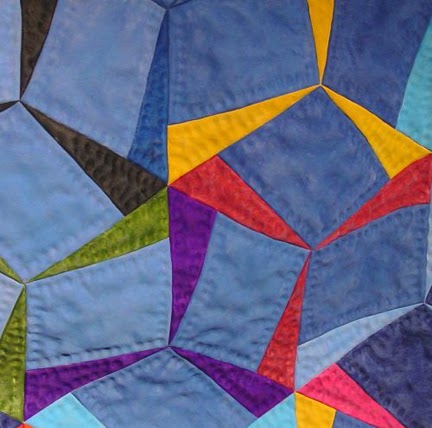Fraser Smith, "30", 2002
This piece is 30" x 53" x 3"
Quilts usually only have two dimensions but this is not a quilt.
It is hanging wall sculpture of carved, dyed wood, three inches thick.
Detail of "30"
See more of Smith's work here:
Fraser Smith, Square Dance, 2005
Again: This is not a quilt.
Rene Magritte, This Is Not A Pipe.
1928-1929
Surrealists and Dadaists walked the line between realism and illusion. Magritte's painting was, in truth, not a pipe. It was a painting of a pipe.
Stephen Sollins's work is inspired by
antique quilts but this unnamed piece is made
of discarded mail---paper.
Artists continue to explore illusion and representation. Several of them use quilts and patchwork as an anchor of reality.
Sabrina Gschwandtner
Wave Hill Sunroom Square
Gschwandtner uses familiar pattern to piece together discarded film, sometimes bleached and altered. Among the film strips in this piece is footage from the documentary Quilts in Women's Lives.
The two artists above are displaying their work at an exhibit at New York City's American Folk Art Museum. alt_quilts: Sabrina Gschwandtner, Luke Haynes, Stephen Sollins will be up until January 5, 2014.
Luke Haynes
Clothes Portrait # 2 Helmet
Haynes also examines illusion. The log cabin quilt above is pieced from the clothing of the man whose portrait is appliqued atop the blocks.
See Haynes's blog:
Read more about the exhibit here: http://www.folkartmuseum.org/index.php?p=folk&id=880
Constanze Schweiger
Rainbow Quilt 1890, 2005
Schweiger paints boards to look like quilts. She pushes the illusion by personally holding them up for the photograph. The photograph itself is the piece of art, adding to the strange contradiction of soft quilt/hard quilt.
Constanze Schweiger
Rainbow Quilt 1888, 2005
See more from this series:
Lesley Dill
Dada Poem Wedding Dress, 1994
Dill directly alludes to her DaDa and Surrealist influences in this piece of art which is an object, a photograph and a performance piece.
She writes about her work:
"The idea was inspired by Duchamp’s The Bride Stripped Bare by Her Bachelors, Even. The dress is a brown paper dress painted white and stamped with the words of the Emily Dickinson poem, 'The Soul Has Bandaged Moments'.
Read more here:
http://www.lesleydill.net/dadaPoemDress.html
Marcel Duchamp
The Bride Stripped Bare by Her Bachelors, Even
1926






















































